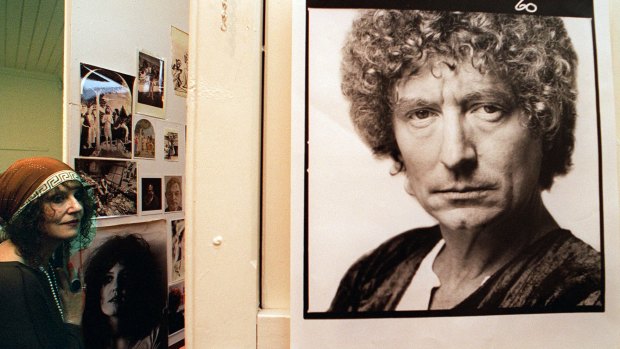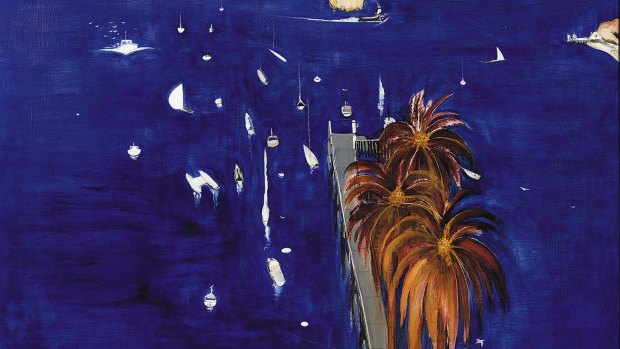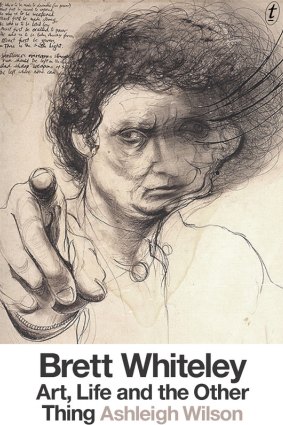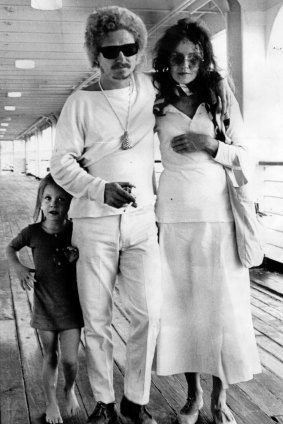By Chris McAuliffe
BIOGRAPHY
Brett Whiteley: Art, Life and the Other Thing
ASHLEIGH WILSON
TEXT, $49.99
The paradoxical condition of contemporary artists is that they are recondite thinkers and plain speakers. They make complex cultural texts that they hope to broadcast to a general audience. But as a rule, there's only a place for artists in the media if their story involves some kind of newsiness – market machinations, art world politics, A-list gossip and low-life scandals.

Wendy Whiteley at the newly opened Brett Whiteley studio in 1996.Credit: William Yang
All of these figured constantly in Brett Whiteley's life, so his story is never only (or even primarily) about his art. In his paintings, the names of legendary outsiders – Rimbaud, Van Gogh, Bacon – were chanted like a spell, declaring Whiteley both fan-boy and heir.
But his press file reads like a cack-handed remake of romantic bohemianism. There he is fanging around Sydney in his Mini Moke, dosing up in exotic locations and railing against bourgeois hang-ups from the shores of Lavender Bay. It didn't help that Whiteley, the son of a publicist and the spiritual child of Marshall McLuhan, thought that the media game was one he could play and win.

Lavender Bay at Dusk (detail), by Brett Whiteley.
After Andy Warhol, many artists have played with the idea of the brand. Whiteley became one. With the Shirley Temple hair and the shades he was a walking logo. He was always on message, even if he delivered it in his own hippie-beatnik dialect. Maybe the worst thing that could be said of Whiteley is that if he'd lived into the age of reality TV, it would have all made sense.
In the face of this, Ashleigh Wilson's new telling of Whiteley is a remarkable exercise in sustained authorial discipline. Whiteley glows white-hot at the heart of a swirling nebula of anecdote, scuttlebutt and middlebrow tabloidism.
But Wilson has chosen his form and voice carefully: this is an American-style artist biography, delivered with a dispassionate formality. The familiar biographical Bell curve is there. There's just enough on childhood and family life to suggest the man-in-the-boy, followed by the central peak of sustained career success, before the gradient tapers off into distraction and addiction.
Wilson has built a robust scaffolding out of Whiteley's letters, notebooks and published interviews, and clads this with the observations of those who lived, worked and partied with him.

Brett Whiteley: Art, Life and the Other Thing, by Ashleigh Wilson.
Among the more touching assessments are those of fellow artists: Lloyd Rees was deeply moved to find a younger artist honouring his influence (still a rare phenomenon in Australia art). Among the more astute are those of show business acquaintances: members of Dire Straits were best placed to understand Whiteley's fascination with celebrity.
Wilson is determined to take Whiteley seriously but not to surrender to him. Everything that might seduce or derail a biographer – Whiteley's epicureanism, his scatterbrained aesthetics, the undeniable electricity of his presence – is kept at bay by sober reserve. The improvised, staccato rhythms of Whiteley's life are slowed and ordered into something resembling connected, even purposeful, episodes.

Brett, wife Wendy and daughter Arkie Whiteley arrive back in Sydney from Britain in 1969.Credit: Martin Brannan
There's a good deal more talk about the art than in previous biographies; more about the ideas Whiteley invested in the works and what he hoped would be their impact. And, with that, the moments at which Whiteley was a properly ambitious and genuinely challenging artist come into focus.
At the end of his narrative, deep in the backlash years, Wilson tables Sydney art critic John McDonald's provocative question, "What if Brett Whiteley was just very, very overrated?" Wilson is surely in a position to give an opinion. He doesn't, because the detachment he has observed throughout prohibits anything that might read as advocacy rather than analysis.
But if Wilson won't, I will. Whiteley was overrated in a familiar, even generic, way. His sheer poise as draughtsman made it easy to mistake dexterity for genius: a convention that John Ruskin had already identified.
More specifically, the sensuality of his colour and contour counted for a lot in a city still clinging to its peculiar fascination with Bonnard. Whiteley was overrated, in strictly local terms, because he was delivering the desired goods.
So the more pertinent questions are "Who was overrating him, and why?" Wilson records genuine excitement among critics of real intelligence in response to Whiteley's major exhibitions of the 1970s. The psychedelic environments, the melding of Zen and Pop in the Australian landscape, the migration of Matisse to Sydney Harbour: this was the kind of provocative, cosmopolitan, "big statement" art that defined a new, post-Menzies Australia. This was the kind of artist we needed, then.
Even Whiteley's showmanship – the room-scale cycloramas, the rock star mannerisms, the sheer Sydneyism of the guy – doesn't make him overrated. Over-exposed perhaps, but that's a different thing.
Rather than simply making art, Whiteley performed his idea of the countercultural artist: part romantic, part media-savvy entrepreneur. A little bit of Warhol and a whole lot of Shelley. Garrulous in the flesh and on canvas too, Whiteley often over-reached: he needed a dramaturge, not a muse. As a new kind of live-in-the-limelight artist, Whiteley was defeated more by sensationalism than philistinism. In Australia, that counts as a kind of a victory.
It's said that every nation gets the government it deserves. I wonder if the same is true of artists; whether it's fair to say that, in Whiteley, Australia got the artist it deserved. He chased the big themes – Evil, Beauty, Endlessnessism – at a time when national cultural ambitions were growing. He pursued international success when cosmopolitanism and ambition were no longer dirty words. He insisted on a spirit of place, but ditched the Dorothea Mackellar script.
It wasn't his fault that he ended up as a dial-a-quote bohemian. Or if it was, that makes "overrated" a moral question rather than an aesthetic one.
In a different sense, Wilson has given Whiteley the biography he deserves. Accommodating, even forgiving on occasion, but never indulgent. Engaged and attentive, unaffectedly interested in the artist, but not uncritical.
A new account of a life already examined, Virginia Woolf suggested, is less about delivering new knowledge, more an opportunity to reposition the subject in relation to our own shifting landscape. Whiteley lamented that his problem with the press was that, "I've never known which Brett to be for them". Reading Wilson, through Woolf's dictum, we can choose which Brett is ours.
Chris McAuliffe is Professor of Art (Practice-led research), School of Art, Australian National University. Ashleigh Wilson is a guest at Melbourne Writers Festival. The Age is a festival sponsor. mwf.com.au